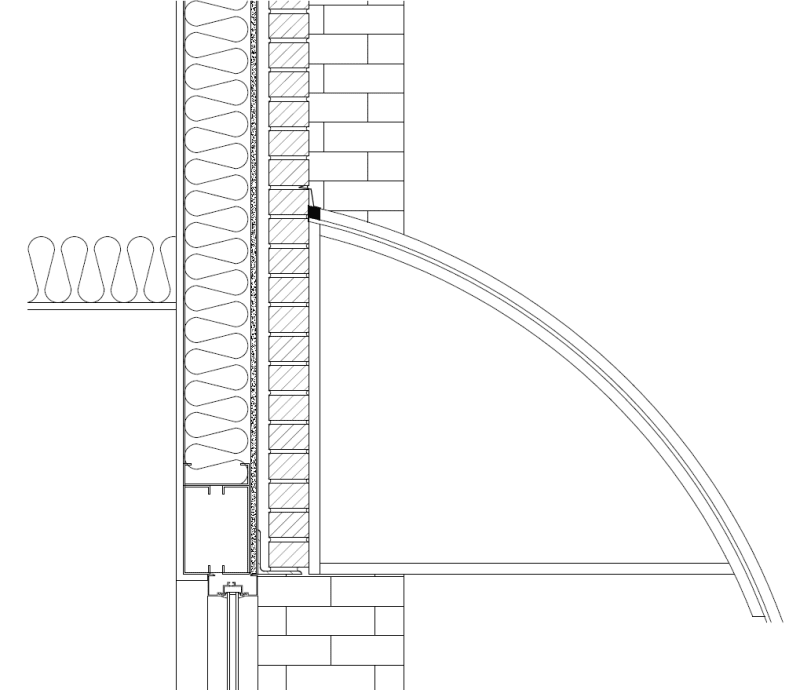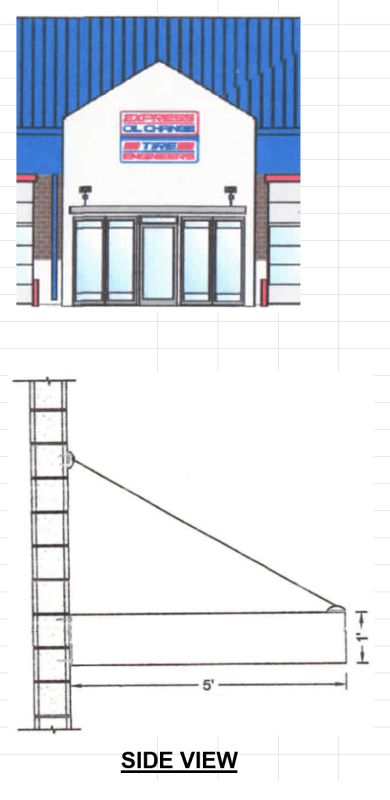I have 2 issues I'd like to get some opinions on. I have these 2 conversations all the time with architects.
1. I design small canopies and awnings for 20 psf roof live load unless they are cloth covered (we have only 5 psf snow). Basically, if you can stand, lean a ladder against or in any way support a person on the item, I design for 20 psf. Architects claim that other engineers do not do that, even though they can never tell me the names of these engineers. The picture below is the most recent request. This is 3' wide and 29' long. As I pointed out, if someone had to clean this, they would have to lean a ladder against the edge. The more the ladder is sloped, the more they vertically load the outer edge of the awning. So, do any of you use a lighter live load than 20 psf other than snow loads that are higher?
2. Also in this same request, they want to anchor to an existing brick veneer only. They have no idea if any wall ties are present or if they are present, what is the spacing? In my area, it is very possible that there are not any wall ties on residential but more likely on commercial. But even when they are present, I have found a lot of buildings where the only got used when someone was watching. In any case, I never allow anchoring to brick veneer only unless this was a very light load with little chance of harm to someone. These canopies always pull outwards somewhere along the wall. The closer to the top of the brick, the more this is a concern. Again, Architects claim that other engineers allow them to anchor to the veneer only, even though they can never tell me the names of these engineers. So, do you typically allow tension and overturning type larger loads to be anchored to brick veneers only and if so, where do you get your "allowable loads" from? I allow some shear only loads at times but have never allowed anything that pulled outwards of any magnitude.

1. I design small canopies and awnings for 20 psf roof live load unless they are cloth covered (we have only 5 psf snow). Basically, if you can stand, lean a ladder against or in any way support a person on the item, I design for 20 psf. Architects claim that other engineers do not do that, even though they can never tell me the names of these engineers. The picture below is the most recent request. This is 3' wide and 29' long. As I pointed out, if someone had to clean this, they would have to lean a ladder against the edge. The more the ladder is sloped, the more they vertically load the outer edge of the awning. So, do any of you use a lighter live load than 20 psf other than snow loads that are higher?
2. Also in this same request, they want to anchor to an existing brick veneer only. They have no idea if any wall ties are present or if they are present, what is the spacing? In my area, it is very possible that there are not any wall ties on residential but more likely on commercial. But even when they are present, I have found a lot of buildings where the only got used when someone was watching. In any case, I never allow anchoring to brick veneer only unless this was a very light load with little chance of harm to someone. These canopies always pull outwards somewhere along the wall. The closer to the top of the brick, the more this is a concern. Again, Architects claim that other engineers allow them to anchor to the veneer only, even though they can never tell me the names of these engineers. So, do you typically allow tension and overturning type larger loads to be anchored to brick veneers only and if so, where do you get your "allowable loads" from? I allow some shear only loads at times but have never allowed anything that pulled outwards of any magnitude.


